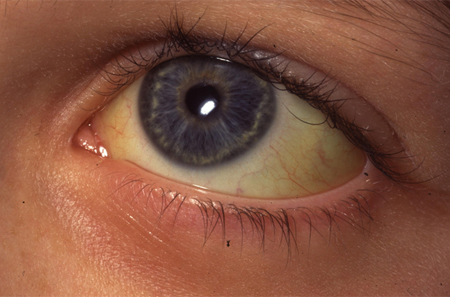History and exam
Key diagnostic factors
common
positive family history
Approximately 75% of cases of HS are dominantly inherited. Therefore, there may be a history of anemia, jaundice, HS, or splenectomy in a parent (who may not know the reason for the surgery).[5]
Nondominant HS can occur as a result of inheritance of a pathogenetic mutation from one parent and a silent low-expressed allele from the other, or from de novo mutations.
at risk demographic
pallor
Nonspecific sign (with or without symptoms). May indicate presence of anemia.
Provokes blood count and blood smear exam, which may reveal the diagnosis.
Anemia is not necessary for the diagnosis.
Acute onset of pallor, lethargy, and fever may occur after parvovirus B19 infection.
jaundice
Due to elevated levels of unconjugated bilirubin. May or may not be present. It is likely to be present in severe HS, and will vary with time.
Nonspecific sign, but should trigger a complete blood count and blood smear review. It may be exacerbated by complicating conditions, such as Gilbert syndrome.[25][Figure caption and citation for the preceding image starts]: Jaundiced sclera in eye of child with HSFrom the collection of Paula Bolton-Maggs, University of Manchester, UK; used with permission [Citation ends].
splenomegaly
The spleen is nearly always palpable in HS. It may be moderately enlarged, but rarely huge.
Splenomegaly may be the only clinical feature in the presence of a normal hemoglobin and absent hyperbilirubinemia, but the blood smear will usually be diagnostic.
The splenomegaly generally does not cause any symptoms or clinical consequences. However, during hyperhemolytic crises, the spleen rarely may become acutely and significantly enlarged and cause left upper quadrant abdominal pain and symptoms of early satiety. The spleen generally shrinks to its previous size between episodes.
Other diagnostic factors
common
fatigue
May indicate presence of anemia.
However, anemia is not necessary for the diagnosis.
Acute onset of pallor, lethargy, and fever may occur after parvovirus B19 infection.
Risk factors
strong
family history of splenectomy, anemia, jaundice, or HS
Approximately 75% of cases of HS are dominantly inherited. Therefore, there may be a history of anemia, jaundice, HS, or splenectomy in a parent (who may not know the reason for the surgery).[5]
Nondominant HS can occur as a result of inheritance of a pathogenetic mutation from one parent and a silent low-expressed allele from the other, or from de novo mutations.
Use of this content is subject to our disclaimer